Archive page
Why Does My Neck Hurt?
Your neck has a tough job. It has to hold, stabilize, and move the weight of your head every day for a lifetime. Holding up 11 pounds may not seem like a lot, but the seven bones and 20 muscles of your neck need to work together in perfect harmony for you to move your head around and keep that weight balanced. Postural changes, sudden injuries, and arthritis are a few of the primary causes of neck pain. Pain can often be traced to a problem with either the muscles, bones, discs, or nerves in your neck.
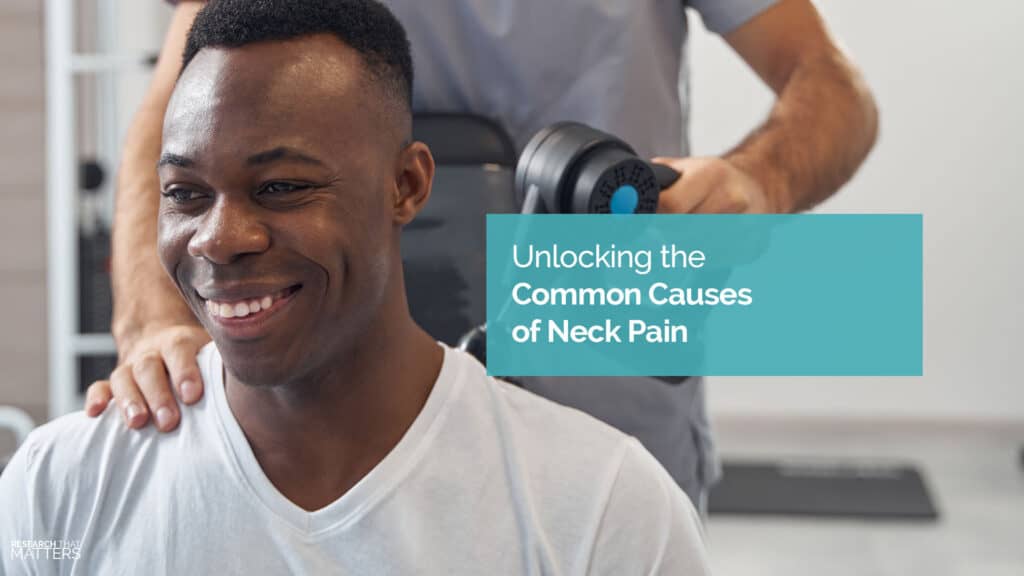
Respond Proactively to Your Pain
If you’ve ever been unable to turn your head for a day or two, you know how debilitating and life-changing neck pain can be. The sharp muscle spasms that restrict your ability to move can happen when your body tries to protect a spinal joint that isn’t moving correctly.
Almost every bone in your neck has a pair of sliding joints towards the back called facet joints. If an adhesion forms or the joint is stuck, your body will try to compensate or work around the issue for a little while. But, over time, this compensation can cause a cascade of additional challenges.
- Sudden injuries, arthritis, and postural issues can all contribute to neck pain.
- The small sliding joints (facet joints) of your neck can become stuck and cause muscles spasms and pain.
- Gentle spinal adjustments combined with daily stretching can help restore the motion of your facet joints and reduce pain.
Pain in your neck is your body’s way of saying “pain attention”! Even if it eases up by the end of the day, it’s a smart idea to have us evaluate your motion. Movement assessments are a part of our examination and provide us with an incredible amount of information about your body. By taking a proactive approach today, you may be able to prevent future episodes of neck pain and stiffness in the future.
Stenosis: How a Pinch in Your Neck Can Affect Your Whole Body
Have you been told that you have spinal stenosis? If so, you’re not alone. Millions of people suffer from spinal stenosis each day, and it’s the number one reason people over 65 years old have spine surgery. Spinal stenosis is the compression, or pinching, of your spinal cord. It can occur due to a disc herniation, bone spur, or ligament overgrowth. However, drugs and surgery are not the only way to find relief.
Take the Pressure Off
For many people, the most significant challenge associated with spinal stenosis is the decreased ability to get up and move! Severe pinching in your neck can cause issues with your arms and legs. One of the best ways to relieve the symptoms associated with spinal stenosis is to open up the spinal canal and take the pressure off the nerves and spinal cord. Many chiropractic techniques focus on decreasing the pressure on your spinal cord, relieving the symptoms associated with spinal stenosis.
- Spinal stenosis is a narrowing of the spaces within your spine, which can put pressure on the nerves that travel through the spine.
- Spinal stenosis is most commonly caused by degenerative changes in the spine related to osteoarthritis.
- Relief can often be found by building up your strength while improving the flexibility and stability of your spine with chiropractic care.
After chiropractic care, many patients report having a decrease in their symptoms, the ability to walk further without pain and find an improvement in their overall quality of life. If you have been slowed down due to spinal stenosis, do not hesitate to schedule an evaluation with us. We will provide a complete evaluation and guide you towards the best treatment options to find relief.
Is My Arm Pain Coming from My Neck?
Pain in your hand, wrist, or arm can be frustrating. You don’t realize how much you use your arms and hands until pain, numbness, or tingling gets in the way. Most of us don’t usually think that an issue in our neck may cause our arm pain. But it’s very common that arm pain can be traced back to a nerve issue in your neck.

Pinched Nerves Can Affect The Arms, Hands, and Shoulders
Hand, wrist, and arm pain often starts with a neck problem. When a spinal disc in your neck irritates or presses on a nerve, it can result in arm pain. Just like the power lines that bring electricity to your house, your brain and spinal cord split into individual nerve roots that deliver information to every part of your body. The nerves in your neck are specifically focused on providing strength and sensation to your head and arms.
- A bulged or herniated disc in your neck can irritate or compress the nerves that travel to your hands, arms, and shoulders.
- A recent study of people with cervical (neck) disc herniation showed improvement in over 86% of people who received chiropractic adjustments.
- Improving spinal mobility, decreasing inflammation, and improving your posture may help prevent future episodes of neck and arm pain.
A painful arm as a result of a pinched nerve in your neck very rarely requires surgery. Most people can find long-term relief with conservative care, such as chiropractic.
Getting rid of the inflammation and giving the disc time to heal are part of a complete plan we use each day to help our patients reduce their symptoms and get their lives back.
Neck Pain: How To Find Relief
An episode of neck pain can quickly hamper your everyday activities. Whether you began experiencing pain due to injury, degenerative spinal changes, or poor posture, it can be difficult to think about anything except the pain when you’re struggling. It’s estimated that 70% of people experience neck pain in their life, but you should know there is a path towards relief.
Small Adjustment. Big Changes.
Neck pain can create everything from headaches to pain in your arms and hands to pain directly on your neck. Different types of pain indicate different issues. The most common reasons for neck pain are strained muscles and stuck spinal joints. Each of these challenges can cause a lot of pain and may have you fearing that you have a more significant issue. But, with a proper examination, our team can pinpoint the cause of your pain and provide a complete plan of care to help you reclaim your life from neck pain.
- Facet joints are small spinal joints at the back of your spine which can become fixated or stuck and cause pain.
- Muscle strains can occur due to poor posture at your desk or sleeping in an awkward position.
- Motion heals: relief typically begins by reducing the inflammation and improving your range of motion.
A small adjustment can make big changes in your quality of life. Our practice is focused on helping you feel (and function) better by improving your spinal motion and then providing you with the stretches and exercises you can do at home to continue your improvement. If neck pain has got in the way of you enjoying your life- give us a call. Our team is here to help.
Science Sources:
Intervertebral Kinematics of the Cervical Spine. The Spine Journal. 2018.
Spinal Stenosis. The Mayo Clinic. 2022.
Cervical Nerve Root Injections or Spinal Manipulative Therapy. JMPT. 2016.
Spinal Manipulation, Medication, or Exercise. Annals of Internal Medicine. 2012.
5 Healthy Habits That Prevent Chronic Disease. Cleveland Clinic. 2020.
Suffering from Neck Pain?
Call or schedule an appointment online to see how we can help ease your neck pain and begin your journey of healing.
Schedule an AppointmentContact UsPerfect Posture is Dynamic
Is there such a thing as perfect posture? The answer may surprise you. The latest research shows that it’s actually more beneficial to think about your posture as dynamic, not static. In other words, your ideal posture is constantly changing and evolving.
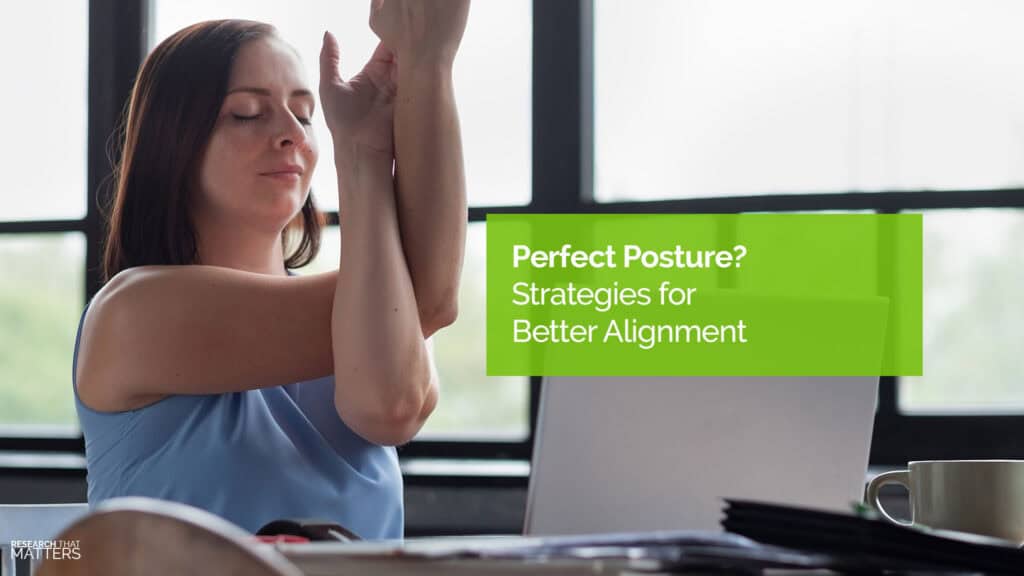
The Negative Effects of Poor Posture
Think of your posture as a dynamic pattern of responses, reflexes, and habits–not just as a fixed position.
Gravity, your work environment, and your body’s anatomy all play essential roles. For instance, sitting for hours at a time staring at a computer screen is a perfect example of a damaging static posture that over time can lead to the development of chronic forward head posture.
Forward head posture affects millions of people who spend their days using computers and has the potential to cause pain and degenerative changes in your spinal joints. It places stress on the neck and shoulders and weakens the supporting muscles.
Here’s what you need to know:
- Forward head posture affects millions and results in neck pain for up to 75% of those affected.
- Neck pain, tension, stiffness, and tenderness are all signs of chronic forward head posture.
- Trapezius strengthening has been shown to provide clinically significant relief for those struggling with neck pain as a result of forward head posture.
If you spend long hours each day in a single position (such as sitting at a computer) it’s important to take the time to take periodic breaks to stretch and move your body.
Remember, posture is dynamic, and stretching can help not only “reset” your posture, but also help keep your spine healthy and your energy levels up!
Scheduling a posture and movement assessment with us is also a smart idea to help ensure you remain as pain-free as possible no matter how you spend your days. Just give us a call!
How to Improve Your Posture
When discussing posture, we’re often referring to the overall position of your body as you stand, sit, or lie down.
Most experts would agree that a “good” overall posture involves physical positions that reduce stress on the body by balancing the load placed on the muscles and ligaments that support the spine.
If you’ve looked in the mirror and noticed that your posture doesn’t look as balanced as you’d like–not to mention, doesn’t feel as balanced as you’d like–you may be wondering what you can do to improve it.
Healing Through Motion
One of the best ways to improve your posture is through motion.
Changing positions frequently during the day, stretching, and specific postural exercises are all ways to improve your posture.
Good posture helps you keep your bones and joints in proper alignment, which helps reduce the wear and tear on your joints and decrease the strain on the ligaments that support your spine.
Here are some key takeaways:
- Good posture means keeping your spinal curves aligned and weight evenly distributed.
- Stretches and exercises can help improve your posture and reduce your risk of neck and back pain.
- Standing desks have been shown to reduce back pain by over 30% when compared to sitting at a desk.
When creating a plan to improve your posture, remember that stretching and exercising are essential. Equally important is knowing where to start.
Our postural and movement assessments can help you determine the best strategy to help balance and improve your posture, especially if you’ve been living with pain.
How Your Smartphone Impacts Your Posture
Believe it or not, many of us spend 3 hours or more per day on our smartphones. That adds up to over 1,000 hours each year! And the positions we tend to hold our heads in while using our devices can be, well… damaging. Damaging to your posture, and damaging to your spine. It’s not surprising that over the past few years, an uptick of these awkward positions has led to an uptick in head and neck pain.

"Tech Neck"
It’s estimated that tilting your head forward, even just 15 degrees, can triple the weight of your head on your neck. In fact, tilting your head forward 60 degrees can increase the stress and strain on your neck ten times over.
Repeating this forward head posture again and again over time can result in pain, stiffness, dysfunction, headaches, and more–a group of symptoms often referred to as “Tech Neck.”
The good news about postural stress and “Tech Neck” is that a few simple changes to your routine can help you reduce your risk of experiencing pain.
Here’s what you need to know:
- “Tech Neck” is the term used to describe the flexed head and neck position that occurs when looking down at your smartphone.
- Just 15 degrees of forward bending can increase the stress of your head on your neck three times over.
- Taking breaks every 15 minutes and looking up from your phone or tablet can help your body reset and give your muscles a chance to relax.
Know that reducing your “Tech Neck” symptoms involves more than just changing the angle you look at your phone. Proper ergonomics and regular stretching and exercise all play significant roles in helping you continue to enjoy your favorite devices without those nagging pains.
If you’ve been living with “Tech Neck” and are ready to take action, you’ve come to the right place! Our expert team is ready to not only help evaluate your ergonomics, but to also provide a plan of action complete with personalized recommendations that will help make it easy for you to maintain a more balanced posture for years to come.
Posture: Balancing Strength and Flexibility
Both strength and flexibility play a significant role in how your posture develops.
For instance, having both a strong and flexible core helps the body to dynamically adapt to every environment. The spine is not only supported but also moves well, reducing the possibility of injury or pain. While it’s true that “perfect” postures may not exist, improving our strength, flexibility, and ergonomics goes a long way towards improvement.
Don't Wait to Get Care
Your body is dynamic, and it’s designed to move, but over time it may feel a bit less dynamic than it used to!
Getting into a wellness routine that includes exercises that focus on strength and flexibility is a smart way to keep your body feeling young while promoting good posture–a true win-win.
Here’s why:
Strengthening exercises can help develop proper support for your joints and decrease overall postural stress. Incorporating stretches and exercise that focus on flexibility then help you body maintain the ability to move through its full range of motion.
Did you know…
- When you focus on increasing muscular flexibility, your posture is likely to improve.
- Lifting weights strengthens your back, shoulder, and core muscles, which are all essential to standing with proper posture and preventing lower back pain.
- Stretching your muscles and joints also leads to a greater range of motion, improved balance, and increased flexibility.
Remember, postural stress can add up over time. Just because you’re not currently in pain doesn’t mean that everything is functioning at its highest level or that your daily wellness routine is as optimized as it could be.
Our team specializes in all things posture and providing comprehensive individualized care plans – adjustments, stretches, exercises, and all!
Schedule an appointment today if you’d like to learn more about all the ways we’re helping the people in your community achieve an ideal balance of strength and posture and flexibility. Our doors are open, and we’re here for you.
Science Sources:
Effects of Trapezius Strengthening on Posture. Med Sci Monit. 2020.
Back Health and Posture. Cleveland Clinic. 2020.
“Tech Neck” Taking a Toll on Posture. Columbia Spine. 2018.
Breaking up Workplace Sitting Time. Occup Environ Med. 2014.
Why Being Flexible is Great for Your Health. Healthline. 2020.
Forward Head Posture and Neck Pain. Curr Rev Musculoskel Med. 2019.
Guide to Good Posture. Medline Plus. 2023.
Upright Posture Improves Affect and Fatigue. J Behav Ther Exp Psychiatry. 2017.
Wondering How to Effectively Improve Your Posture?
Let us help! Call or schedule an appointment online to see how we can help improve your posture, decrease your pain, and live a better, healthier life.
Schedule an AppointmentContact UsBe Smart With Your Smartphone and Look Up!
As students worldwide return to school, it’s likely many will be e-learning in some capacity for hours each day on their digital devices. While our devices can be fantastic tools for entertainment and education, the postural effects are something all parents should be aware of. For many students, e-learning may increase neck, mid-back, and low back pain.
How Digital Devices Can Affect Your Health
Spending 6 or more hours each day looking down at your digital devices can profoundly affect your mental, social, and physical health. It can also lead to the development of “Tech Neck Syndrome.” This forward head posture often places tremendous stress on the neck (cervical spine) and can lead to an uptick in headaches, back and neck pain, and more.
Did you know…
- Low back pain is the 3rd most common form of pain interfering with schoolwork.
- It’s estimated that 50.3% of school-aged children present with posture disorders.
- In fact, approximately 6% of children experience back pain from prolonged sitting.
Making it a habit to look up (literally!) throughout the day is a significant first step in reducing the effects of “Tech Neck.” Try this. Pull your chin back, stretch your arms out in front of you and open them wide, and look up to the ceiling and hold for 20-30 seconds. Try and repeat this stretch every 60 minutes to help reset your posture and body position. And if your child spends every day at their computer learning, be sure to teach them this stretch and then schedule a visit with our practice. We’ll provide you with a full postural and movement-based assessment to identify any potential issues to help reduce their chance of suffering from “Tech Neck Syndrome.”
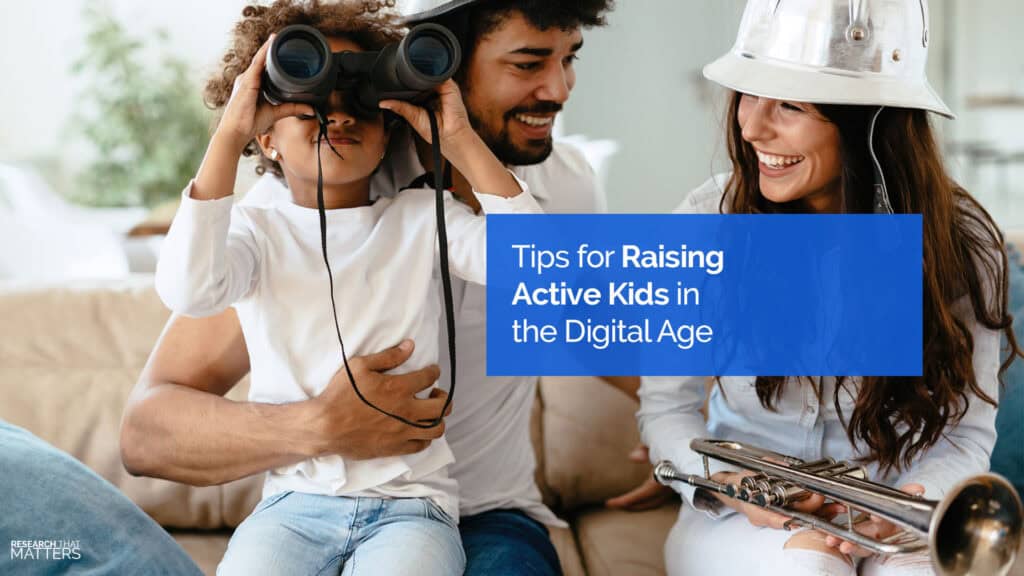
Why Chiropractic Care is Critical for Kids Who Play Sports
Youth sports are a big deal. It’s estimated that over 45 million kids are actively engaged in sports! While sports give kids a fantastic opportunity to grow socially and physically, they also increase risks for injuries, pain from overuse, and muscular imbalances. Finding proactive ways to reduce the risk of injury and balance the effects of training are essential for your child’s developing musculoskeletal system.
Ensure Proper Musculoskeletal Development
Your child’s skeletal system is actively developing until they are approximately 25 years old. Their postural habits, history of injuries, and genetics play a role in their body’s final form (and function). Sports have the potential to add a significant amount of stress and increase the chances of injuries for your developing child. Even small injuries to their spine can create bigger challenges down the road as they get older.
To recap:
- Addressing minor injuries and challenges while your child is young can help ensure proper musculoskeletal development.
- Youth sports can increase your child’s likelihood of developing overuse, growth plate injuries, and chronic pain.
- Chiropractic care is a safe and natural way to help your child stay active and perform their best.
Remember, don’t shrug it off if your child complains of back pain, headaches, or a stiff neck. Pain is a signal to “Pay Attention Inside Now.” The good news? Our practitioners are experienced at evaluating active children and creating kid-friendly care plans. Together, we can help your child stay engaged with their favorite sports for years to come.
Power Your Child’s Brain with Movement
Years ago, many believed that the health benefits of exercise were limited to the body. However, research has demonstrated that regular physical activity and movement can benefit both the body and the brain. Recent studies have highlighted that movement can improve the supply of oxygen to the brain and promote the production of new cells. In fact, it appears movement also aids in creating new connections in the brain!

The Benefits of Daily Movement
Many schools have reduced physical education classes. Many more students have moved towards e-learning. For those reasons, it’s important to be mindful of our children’s physical activity and to encourage them to exercise more each day. And not just to benefit their physical health. In many ways, exercising each day is likely to make your child a better student! Movement triggers the release of chemical substances in the brain that enhance brain function.
Here’s a quick snapshot of the benefits of movement:
- Better Brain Function – Movement may protect your brain against degenerative changes.
- Better Stress Reduction – Exercise and movement have been shown to have an antidepressant effect that can help reduce overall stress.
- Better Memory – Regular exercise can help directly and indirectly improve recall and reasoning skills.
The research is clear. Daily movement and exercise are healthy for both your child’s body and their brain. And our posture and movement assessments are designed to help you identify any abnormal patterns, helping your child feel better and stay active so they can become the best student possible. So, if your child struggles to get enough exercise due to nagging aches and pains or less than ideal posture, we hope you’ll consider scheduling an appointment with us today. Our doors are open, and we’re here to help!
E-Learning: How to Avoid Tech Neck
Is your child connected to a phone, computer, or tablet during and after school? Think about it. Many of us aren’t more than an arm’s length from our phone at any time (even when we are sleeping). Spending time every day looking down at our devices can place a lot of stress on the supporting muscles of our neck and lead to an uptick in headaches. It’s a condition called “Tech Neck,” and it’s one of the most common causes of headaches and neck pain.
Don't Wait to Get Care
The countless hours per day kids often spend on phones and computers can significantly contribute to tension headaches. In fact, it’s estimated that kids spend up to 1,400 hours per year in the exact positions that are attributed to the development of “Tech Neck.” That’s not surprising. Recent research has also shown that even 15 degrees of forward head tilt can triple the weight of the head on the spine.
Here are some key things to remember when it comes to “Tech Neck”:
- “Tech Neck” is the term used to describe the symptoms of headaches, neck pain, and poor posture attributed to the forward head posture often associated with using your phone, tablet, and
- Taking a break from our mobile devices every 15 minutes can help reduce the likelihood of developing recurring neck pain and headaches.
- Chiropractic care including adjustments and postural exercises can help decrease the pain and reverse the effects of “Tech Neck”.
Keep it simple. Encourage your children to take breaks and stretch often. These are some of the best (and easiest) ways to help them break the bad habits that can lead to “Tech Neck.” And if your child spends alot of time online and begins experiencing neck pain or headaches, don’t hesitate to give us a call. Our providers are experienced at evaluating children and creating kid-friendly care plans. Our doors are open, and we’re ready to help you and your family find long lasting, natural relief from “Tech Neck.”
Science Sources:
Text Neck Syndrome. Intl Journal of Env Research and Public Health. 2021.
Three Steps to Build a Better Back. Harvard Health Pub. 2015.
Back Pain in School Children. Dynamic Chiropractic. 1995.
School Children’s Backpacks, Back Pain and Back Pathologies. Arch Dis Child. 2012.
Backpack Safety: It’s Time to Lighten the Load. National Safety Council. 2020.
Specialization & Overuse Injuries in Young Athletes. UCONN Health. 2017.
Learning Upregulates Neurotrophic Factor. Behavioral Neuroscience. 2019.
The Anti-Depressant effect of Running. Intl Journal of Neuropsychopharmacology. 2005.
Regular Exercise Changes the Brain. Harvard Health Pub. 2014.
How Exercise Affects Your Brain. Scientific American. 2018.
Assessment of Stresses in the Cervical Spine caused by Posture. Surg Tech Intnl. 2014.
Help Keep Your Children Healthy
Is your child suffering with neck or back pain? Call or schedule an appointment online to see how we can help.
Schedule an AppointmentContact UsWhat Causes Low Back Pain?
Low back pain is the number one reason people worldwide visit their doctor and miss work. If you’ve dealt with it in the past (or maybe even right now), you know back pain can change your life in an instant. Not being able to enjoy hobbies, difficulty in your ability to work, and a sneaking suspicion that you may never get “back to normal” are all normal when you’re experiencing a bout of back pain. So why do so many people struggle with back pain?
Habits, Stress, and Injuries
In many cases, your daily habits are a big contributor to your back pain. Repetitive stress, nagging injuries, a diet filled with inflammatory foods, and a lack of daily exercise and movement can contribute to an increased likelihood of back pain. Here are the three most common causes of back pain.
- Sprain/Strain Injury: Repetitive stress can create inflammation and lead to sprain/strain injuries.
- Spinal Disc Issues: Disc bulges and herniations can cause back pain that travels by pressing on your spinal nerves.
- Arthritis: As you get older, your body will go through degenerative changes, but if your spinal joints get inflamed, you may notice pain associated with arthritis.
For over 80% of us, back pain will be something we deal with at some point in our lives. And while it may feel like you’ll never get back to your old self, chances are you will. An overwhelming majority of people recover from back pain naturally or with a little additional help from a chiropractor. Even if you recover by taking it easy for a few days, it’s still a smart decision to visit a chiropractor to discover the specific steps you can take to reduce your chances of experiencing back pain in the future.

How to Move Your Way to Back Pain Relief
Movement is one of the best ways to recover from back pain. Science has shown us that medications and rest are a few of the least effective ways to find relief. Your body is designed to move, and often it’s a lack of daily movement (or chronic postural changes) that causes back pain to begin in the first place.
Discovering the right movements and exercises can help you recover more quickly and prevent future back pain episodes.
Movement is Critical
Your body has three types of movements: Segmental, regional, and whole body. Segmental motion occurs between the individual joints of your body. Regional movement occurs in a body region such as your neck, mid-back, or low back. And whole-body movement is typically what we think of as exercise. All three types are essential and work together to keep your spine and musculoskeletal system healthy and functioning at its best.
- Segmental Movement: Moving the individual joints of your body is what chiropractors are specifically trained to do. Proper segmental movement can help reduce pain, improve your range of motion, and influence your central nervous system.
- Regional Movement: Dynamic stretching with regional range of motion exercises can reduce low back stiffness.
- Whole Body Exercise: Daily whole-body exercise can help your brain and body feel better as well as improve your rest and recovery at night.
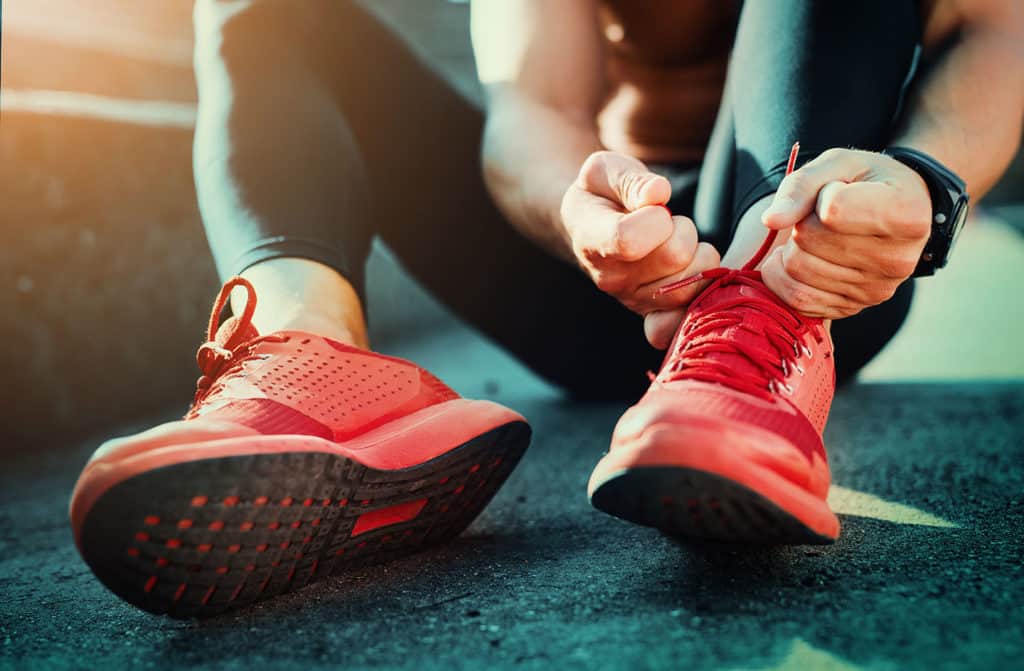
The foundation of all movement is segmental. If your joints aren’t moving correctly, then you’ll never be able to optimize your regional or whole-body movement. Moving may be the last thing you want to do if you’re struggling with back pain. But top research organizations have proven that proper movement and exercise are two of the best ways to find relief from back pain. If you’ve dealt with back pain, call us today. Our team will be happy to provide you with a complete movement assessment and personalized movement and exercise plan to help you get (and stay) well for years to come.
Is My Leg Pain Coming from My Back?
It may seem weird to think that leg, calf, or foot pain can often be traced back to a low back problem. But if you’ve had pain in your leg or foot, a pinched nerve in your low back may be creating your issue. Pain that travels along a spinal nerve is called radicular pain, and it’s one of the most common types of pain that occurs as a result of spinal nerve compression.
How Spinal Nerves Affect Leg Pain
Your spinal nerves can be pinched or compressed by bone, disc, or ligament. Facet hypertrophy or bone spurs sometimes grow large enough to pinch your spinal nerves. Disc herniations or bulges can invade the space of your nerves and cause narrowing of the canals. And ligament hypertrophy can happen with age and injuries and ultimately cause your nerves to get squeezed. Whether your pain is coming from bone, disc, or ligament, it’s important to know that all have a great chance of recovery without the need for drugs or surgery.
- Bone Spurs – bone spurs or osteophytes form due to joint damage associated with osteoarthritis.
- Disc Herniations – disc bulges, herniations, or tears can cause inflammation and pressure on your spinal nerves.
- Ligament Hypertrophy – ligamentum flavum hypertrophy or overgrowth happens due to biomechanical stress and aging.
Leg pain that begins in your low back can start with an injury or for what seems like no reason at all. Either way, your body is telling you to Pay Attention Inside Now! Every day our practice helps people regain their quality of life from compressed nerves. Reducing inflammation, establishing proper motion to your joints, and taking proactive steps to reduce the likelihood of the pain coming back are all part of our care plans. If you’ve felt leg pain, give us a call today.
Why Medications Aren't Recommended for Low Back Pain
A staggering 100,000 people each year are hospitalized due to NSAIDs. Just because these medications can be purchased over the counter doesn’t mean that they don’t have risks and dangers. Leading healthcare organizations have taken note and now recommend that movement-based care options, such as chiropractic, are explored for most low back issues before any medications. The added benefit is that most people who explore chiropractic care take far fewer medications than those who don’t. Why? Because it works.
An Alternative to Medications
Over the past twenty years, we’ve seen the effects of low back pain change our healthcare landscape forever. The numbers of people with low back pain have remained the same even as we’ve lost millions to the opioid epidemic and hundreds of thousands more due to complications from NSAIDs. The good news is that major healthcare organizations have updated their guidelines, and the care that chiropractors deliver ranks at the top of nearly every list.
- Over 100,000 people are hospitalized each year from NSAID related complications.
- Each day, over 100 people pass away due to Opioid overdoses.
- Leading healthcare organizations now recommend the care delivered by chiropractors as the best first-line treatment for low back pain.
Medications are designed to mask the pain, not fix the problem. Receiving a complete and comprehensive evaluation is the first step towards finding relief. After discovering the cause of your pain, we can work together to craft a care plan that will help you reach your health goals. If you know someone struggling with low back pain, call us today.
Start Feeling Better Today!
Schedule a complimentary consultation to see how we can help relieve your low back pain.
Schedule an AppointmentContact UsWhiplash: The Symptoms You Need to Know
Whiplash is an injury that occurs when your body is suddenly forced backward and forward. It’s the most common injury that happens during an automobile accident, and it’s one of the leading causes of chronic neck and back pain. While a little fender bender may not seem like a big deal, new research has shown that even small accidents can result in significant injuries.
The violent forces that occur during an auto accident can cause damage to your spinal discs, ligaments, tendons, and bones-even at “low” speeds. Most of these injuries happen because your head is whipped backward and forward very quickly. This rapid back and forth motion frequently results in ligament tearing and spinal disc injuries. Symptoms such as neck pain, back pain, headaches, confusion, and even depression indicate that you’ve suffered a whiplash injury. Because of a spike in adrenaline at the time of the accident, you may not immediately notice any immediate pain. For many people, these symptoms may take hours or even a few days to develop after the initial shock of the car accident wears off.
- Whiplash is an acceleration-deceleration injury that can affect your ligaments, spinal discs, muscles, and facet joints.
- There is often a period of little to no pain before the symptoms become worse.
- Symptoms of whiplash include neck or back pain, headache, radiating pain, confusion, and difficulty sleeping.
It’s smart to get a complete evaluation after an auto accident to minimize your risk of long-term pain. Getting the right care at the right time can make a big difference in your ability to heal quickly and avoid long-term chronic pain. Remember, even small accidents can cause injuries, so if you’ve been involved in an auto accident, be sure to reach out to our office as soon as possible so we can help you get on the relief road.

How Long Does Whiplash Last?
Symptoms of whiplash include neck pain, back pain, headaches, dizziness, or confusion—none of which sound like a good time. So if you’ve been involved in a car accident, you may be wondering how long these symptoms are going to last. The good news is that with a proper evaluation and early treatment, you have a high likelihood of getting well within a matter of weeks.
Ligament Tearing
One of the most common injuries associated with whiplash is ligament tearing. Ligaments are short, tough bands of connective tissue that hold together the bones in your neck and joints of your body. If these ligaments are torn, it can cause neck pain. The average time it takes a ligament to heal is about six weeks with the proper care and treatment. If you notice symptoms like headaches, dizziness, or memory issues, you may have suffered a mild traumatic brain injury (mTBI). A majority of people with a mild TBI recover within three months.
- Whiplash injuries frequently cause tearing of the ligaments that support proper spinal motion and stability.
- The acute inflammatory phase of injury lasts up to 72 hours, the repair phase takes up to 6 weeks, and the remodeling phase of healing can last up to a year.
- A non-healed ligament injury can result in osteoarthritis.
After an accident, the most important step you can take is to receive a full evaluation. Only after a complete evaluation will you be able to know what type of injuries you’ve sustained, and, most importantly, how to get well. You would be surprised at how many people shrug off a “small” accident and push their symptoms aside. While that may save you a little time today, it’s likely to result in much more pain down the road.
Shoulder Pain After a Car Accident: What does it mean?
You may be surprised to learn that shoulder injuries are some of the most common challenges after a car accident, in addition to whiplash. If you are the driver and have your hands on the wheels at the time of the crash, the sudden force created by the accident can lead to a torn rotator cuff. Your shoulder is one of the most complex parts of your body and is made up of a collection of bones, ligaments, tendons, and muscles.

The Rotator Cuff
The rotator cuff is a ball and socket joint made up of three bones: your arm bone (the humerus), your shoulder blade (the scapula), and your collarbone (the clavicle). The supporting muscles, ligaments, and tendons are designed to help you lift and rotate your arm. Your shoulder is one of the most dynamic and unstable joints in your body. It’s hard to ignore a torn rotator cuff because…it hurts! Signs of a tear include shoulder pain when lifting your arm, weakness, pain when lying down, or a limited range of motion.
- Shoulder impingement (the pinching or rubbing together of tissues inside a joint) has been estimated to occur in up to 10% of people involved in car accidents.
- The shoulder is one of the most complex, dynamic, and unstable joints in the body, with a complex network of bones, ligaments, and muscles.
- The risk of neck or shoulder pain seven years after a collision was three times higher for patients with initial whiplash injuries than those without.
Ignoring a shoulder injury after a car accident is not a good idea. Your shoulder is designed to move, and if you try to “let it heal” by not moving it, then you’re putting yourself at risk for a frozen shoulder. Frozen shoulder, or adhesive capsulitis, is when your shoulder develops adhesions due to lack of movement. This can result in severe pain that takes months to heal. If you have shoulder pain after an accident, time is of the essence! Our team is here and can provide a complete evaluation and treatment plan for you to get moving safely and heal quickly.
Finding Relief After a Car Accident without Drugs or Surgery
Screech. Bam. Uh-oh. You’ve been involved in a car accident. Your day has been thrown upside down, and a million thoughts are racing through your head. If you don’t feel immediate pain, you may be tempted to think you don’t have a problem. But waiting too long to seek care has been shown to increase the chances that you’ll need more aggressive interventions. Taking the right action steps as quickly as possible after a car accident can make a huge difference in your overall health and healing. With the stress of an accident, calling the insurance company, getting a car repaired, etc., it’s not uncommon for people to make the mistake of putting their health and well-being last on their to-do list.
Don't Wait to Get Care
The problem is that the longer you wait to get evaluated and receive care, the higher your likelihood becomes of needing more aggressive medical care. Without a proper diagnosis and treatment, your body may begin to “heal” with more scar tissue than necessary. You may also try to live “around” your injuries, which can cause additional stress and compensation on other parts of your body and lead to additional injuries. Research has shown that active care involving range of motion, mobilizing exercises, and strengthening can effectively reduce pain. To give yourself the best chance to find relief without the need for drugs or surgery, we recommend three simple steps.
The three steps to finding relief after a car accident :
- Get an evaluation: A full evaluation can provide you with an accurate diagnosis and treatment plan.
- Begin receiving care: After reducing inflammation, movement-based techniques are often recommended to help you regain your quality of life.
- Stay consistent: Getting well is a process. Stay consistent with your care to heal as quickly as possible.
Next Steps
There’s no way around it- auto accidents aren’t fun. But with the right healthcare team, most people can get back to their full life and activities without the need for drugs or surgery. The key is to follow the three steps of evaluation, care, and consistency. While it seems simple, following the three steps will give you the best chance to get well quickly and stay well for years to come.
Been in an Accident or Suffering with Whiplash?
Call or schedule an appointment online to see how we can help you begin healing from whiplash and other car-accident-related injuries.
Schedule an AppointmentContact UsWhat are Spinal Discs Made Of?
We all know spinal discs are important- but to understand why, the real question is; what are they made of? Your spinal discs are little cushions that sit between the bones or vertebrae in your spine. Each one of your discs is made up of a tough, fibrous outer layer (annulus fibrosis) and a jelly-like inside layer (the nucleus pulposus). The tough outer layer contains and protects the softer inside layer. These small discs have a big job. They enable your spine to move in all directions.
Why it Matters:
The nucleus pulposus (inner layer of the disc) is mostly made up of water. The high water content helps your discs stay supple and moveable. It acts like a small swivel to allow your body to tilt and rotate. As you get older, your discs tend to lose their high water content and can become degenerative. Degenerative discs don’t move as well, are more prone to cause pain, and even contribute to compression on your spinal nerves.
- Your spinal column has 24 moveable bones with spinal discs between each pair.
- Spinal discs are designed to help you move in all directions.
- Movement of your spine can help keep your spinal discs healthy.
Movement is one of the best ways to keep your spinal discs healthy. Since your spinal discs don’t have a very good blood supply, movement is how they bring in nutrients. Moving your spine helps your spinal discs get in nutrients to stay healthy and push out waste contributing to pain and inflammation. If your neck or back hurts, give us a call – we’ll help you get your life back from pain.
Types of Spinal Disc Problems
If you’ve had a spinal disc problem, you know how painful it can be. Every movement seems to hurt, and it can feel like you’ll never be back to your old self. But, with the proper care and a little time, you can get your life back. Pain is a signal to “Pay Attention Inside Now.” If you notice neck or back pain, it’s a warning sign from your body. It’s your body’s way of letting you know you’ve pushed past its limits.
Why it Matters:
The most common type of spinal disc problem is called a bulge or herniation. A disc bulge or herniation is when your spinal disc’s inner portion is trying to (or has) pushed through the tough outer layer. When the inside pushes or bulges, it can cause pain in two different ways. If the disc bulges far enough to press on a spinal nerve, you may notice pain that travels down your arms or legs. If the inside of your disc pushes through the outer layer, it could also cause severe inflammation resulting in pain.
- A herniated disc is when the soft middle of a spinal disc pushes through the tough outer layer.
- Age causes the spinal disc to dehydrate, cartilage to stiffen, and can result in disc bulges/herniations.
- Exercises that “centralize” your spinal disc may be able to prevent future episodes of sciatica.
Spinal disc injuries most commonly occur between 45-65 years of age. If you have spinal pain or pain that travels down your arm or leg, you may be suffering from a disc injury. The good news is that your spine is incredibly resilient. Research has proven that movement-based care, such as spinal adjustments and spinal rehab, is incredibly effective at helping you heal from spinal disc injuries. Our practice focuses on using the latest research-based movement treatments to reduce your pain and improve your quality of life.
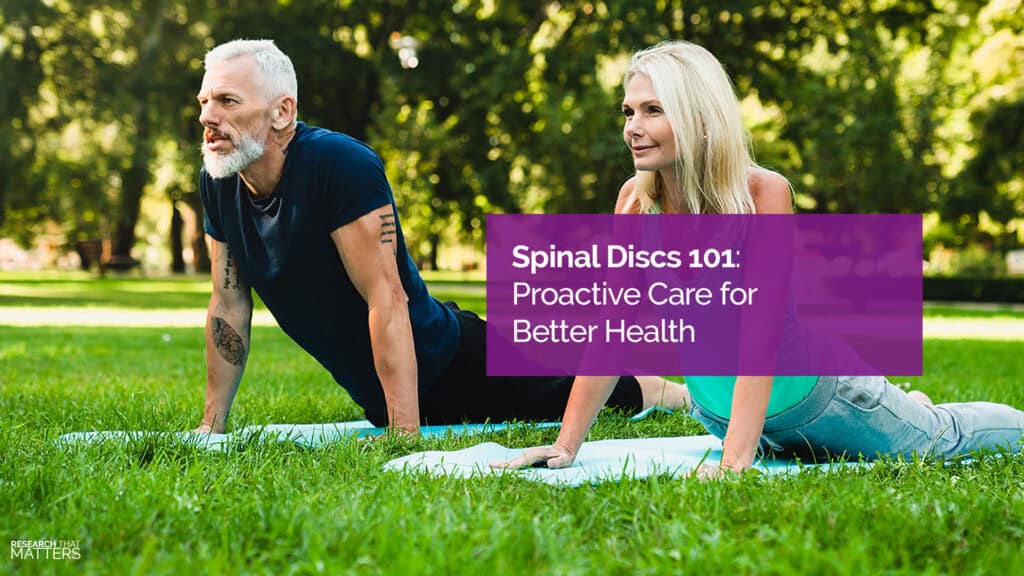
How to Strengthen Your Spinal Discs
No one wants to deal with back pain. If you’re struggling with pain today or looking to reduce your risk in the future, you may be curious about how you can strengthen your spinal discs. When you think about strengthening your disc, you need to consider how you strengthen your core. Your core is the set of muscles, ligaments, and tendons that support your spinal column and help your spinal discs move.
Why it Matters:
Your core needs to have a balance of strength and flexibility. Strengthening your core allows your body to have the support it needs to move, bend, and twist without causing injuries. Flexibility is also crucial. Being able to move through your entire range of motion helps your spinal discs stay healthy.
- Core exercises can help your back maintain a balance of strength and flexibility.
- Movement of your spine promotes the delivery of nutrients to the spinal discs.
- Spinal adjustments can improve your range of motion and decrease pain.
Maintaining the proper balance of strength and flexibility can help keep your core and spinal column functioning at their highest level. It is much easier to keep your spine moving than to get your spine moving. It’s been said that we don’t get old and stiff; we get stiff and then old. Our practice is here to help you stay active, healthy, and happy. Contact us today to schedule a visit to assess your movement and create a plan of action to keep you pain-free and at the top of your game.
Keeping Your Spinal Discs Healthy
Proactively doing things today to help your spinal discs stay healthy in the future is a smart idea. Ain’t no one got time for back pain! Every day your spinal disc absorbs stress related to gravity, your posture, and your movement patterns (or lack thereof). Over time this stress can cause your discs to degenerate and become painful. If you want to minimize your chances of back pain in the future, here are a few ways you can keep your discs healthy starting today.
Why it Matters:
Movement and exercise are the top ways to keep your spinal discs healthy. Each day try to move your spine through its full range of motion and be cautious about sitting for hours in front of a computer. Using a standing desk can help to engage the small muscles supporting your spine, which is essential for your disc’s health. Another thing to keep in mind is your posture. The combination of inactivity and long periods in an unbalanced posture can wreak havoc on your spinal discs.
- Prolonged sitting significantly reduces the disc height of L4-L5.
- Changing positions every 15 minutes helps the discs retain their height.
- Use a standing desk and change positions frequently to reduce your risk of low back pain.
Keeping your spinal discs healthy is one of the best things you can do to reduce your risk of experiencing neck or back pain. If you spend long hours at the computer, you need to take proactive steps to counteract that stress. Call us today, and we’ll be happy to work with you on a plan to keep your spinal discs healthy for years to come.
Sources:
Intervertebral Disc: Anatomy-Physiology-Pathophysiology-Treatment. Pain Practice. 2008.
Bulging Disk vs. Herniated Disk: What’s the Difference? Mayo Clinic. 2022.
Exercise for Sciatica from a Herniated Disc. Spine-Health. 2021.
Exercise and Physical Therapy for Treatment and Pain Management. Spine-Health. 2006.
Let us Help You with your Spinal Health Today!
Call or schedule an appointment online and we can help you gain and maintain healthy discs, enabling you to achieve your goals so you can live your best, most healthy life ever!
Schedule an AppointmentContact Us
